Yoshimura history -25
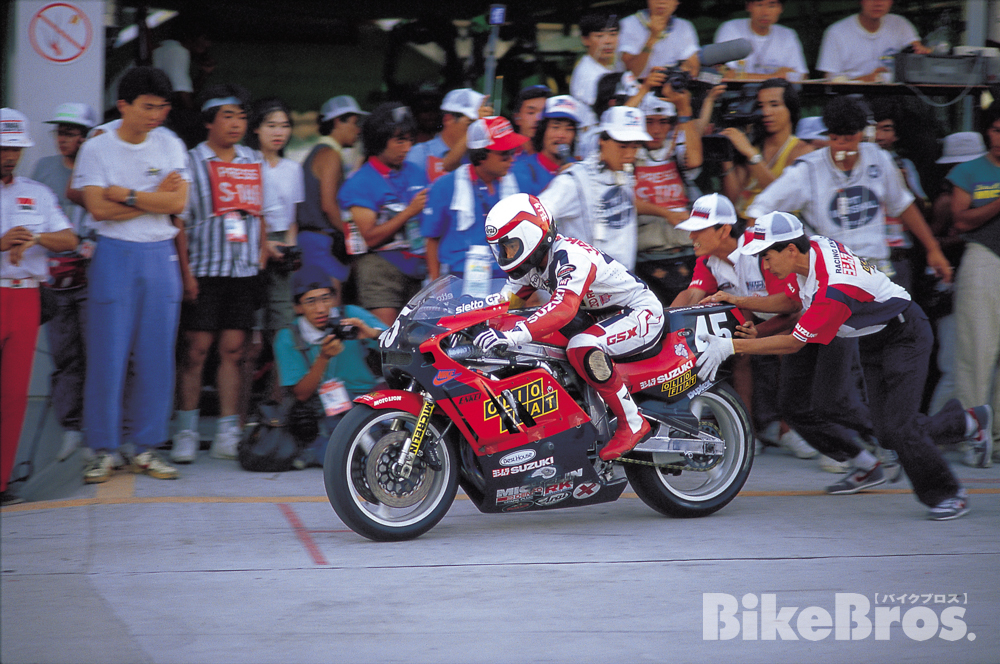
Round 5 of the 1987 World Endurance Championship, the Suzuka 8 Hours, came down to the final on July 26. After smoothly refueling, changing tires, and switching riders (from Goodfellow to Takayoshi), the #45 Yoshimura Suzuki GSX-R750, the leader in this race, was spiritedly pushed out of the pit by the mechanics. In preparation for the final stint as the sun begins to set, Takayoshi has replaced the visor on his helmet with a clear one.
Yoshimura History 25: Takayoshi Leads the 1987 Suzuka 8 Hours into the Last 5 Minutes.
1987 Almost 1st Place
Due to Satoshi Tsujimoto’s challenge to AMA Superbike series, Yoshimura’s All-Japan TT-F1/TT-F3 challenge was entrusted to two young riders. The ace is Yoshimura’s second-year rider Yukiya Oshima (born January 30, 1965 in Fukuoka Prefecture), who finished 2nd in the All-Japan TT-F1 ranking the previous year behind Satoshi Tsujimoto. Another rider, Katsuro Takayoshi (born May 12, 1963 in Kagoshima Prefecture), was in his first year with Yoshimura, and had won the Suzuka 4 Hours, a festival for amateur riders, the previous year. Takayoshi at that time was racing a Yoshimura-tuned Suzuki GSX-R400 in the RT Mirage Kanto, which was a sort of satellite team for Yoshimura, and Pop was overjoyed to welcome the two youngsters (Takayoshi and Hitoshi Ishigami) as if they were his grandchildren.
In the 1987 All-Japan TT-F1, in addition to Yamaha (YZF750) which had been competing since 1985, Honda (RVF750) which had only competed up to the Suzuka 200km in June of the previous year began to participate in all rounds, and although not in every round, Kawasaki (ZXR-7) also sent its factory team. This marked the beginning of an era of fierce competition between factory teams.
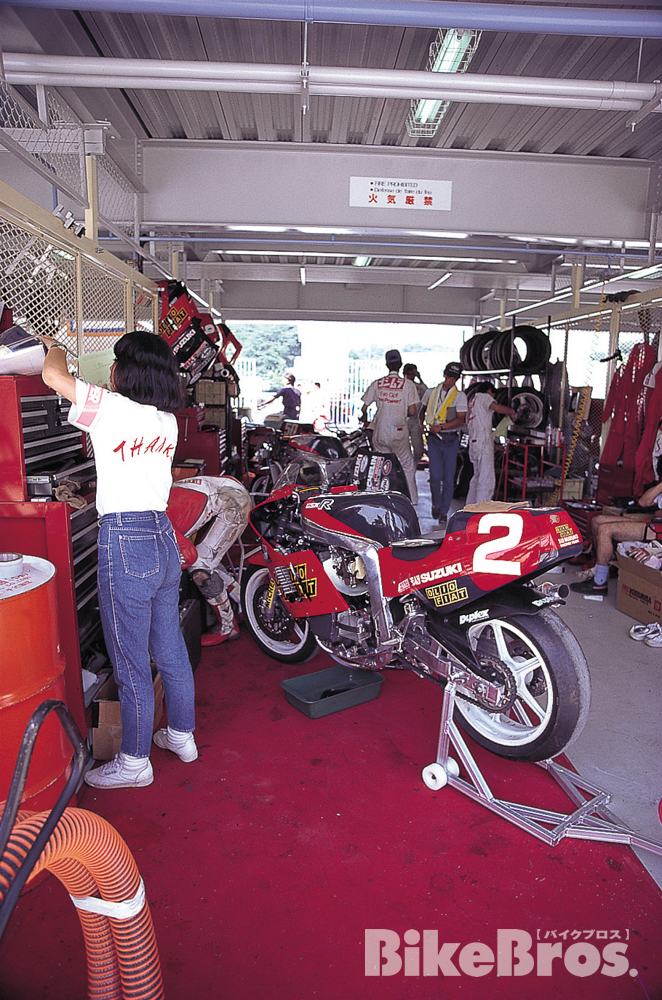
For the first time with oil-cooled machines, the team challenged not only sprint races but also the Suzuka 8 Hours with full fairings (half fairings had been used in the Suzuka 8 Hours for the past two years). The Yoshimura staff was fired up to win the All-Japan TT-F1 championship for the third year in a row, but their bike was no longer superior, and was rather underpowered compared to factory racing machines such as the Honda RVF750 and Yamaha YZF750.
This was due to the fact that the Suzuka 8 Hours, which is held under the same TT-F1 regulations, has become extremely popular, and all the manufacturers were desperate to win the race. In addition, factory teams from Honda and Yamaha were also competing in TT-F3, and their machines —- Honda RVF400 and Yamaha YZF400 —- were as cutting-edge as those in TT-F1, making it the most high-level middle-class race in the world. As a result, both the All-Japan TT-F1 and TT-F3 were in fact the world’s top production bike races, and as a race for 4-stroke bikes (although 2-stroke bikes also raced together), they were at the top level in the world.
However, Yoshimura’s ace rider Oshima was unable to ride the wave of the All-Japan TT-F1 class, finishing 7th once in three rounds from Round 1 to Round 5 (of these, only three rounds of TT-F1 racing were held). Takayoshi, on the other hand, had one 3rd place podium finish and one 7th place finish, not bad results for a rookie.
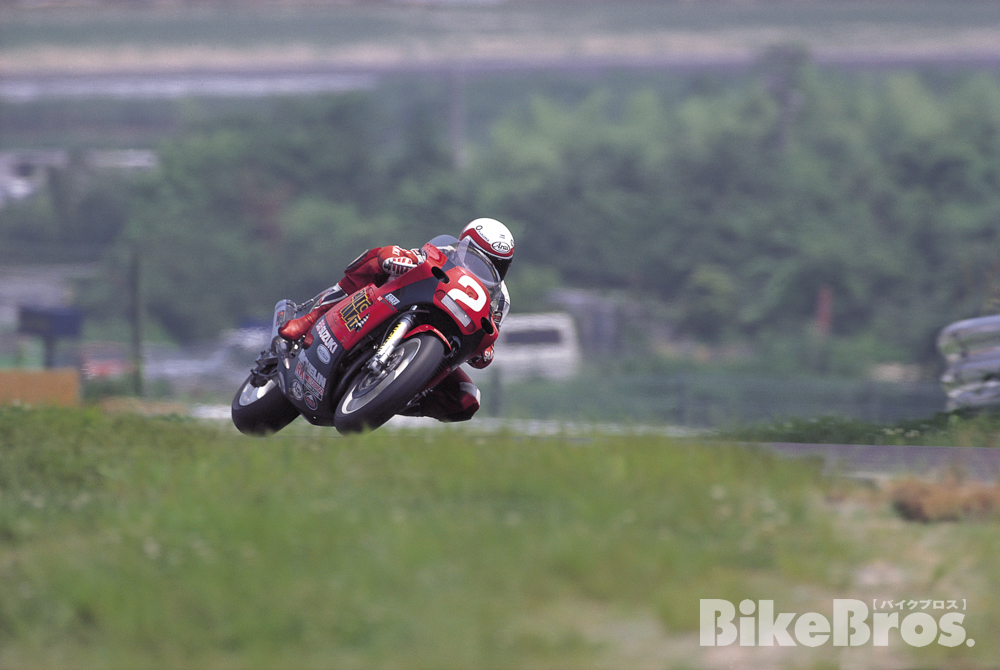
Oshima finished 2nd in the 1986 All-Japan TT-F1 ranking, and although he did not have the results he wanted in the first half of the 1987 season, he started to recover from the Suzuka 200km race in June. The main sponsor changed from MOTUL to OLIO FIAT (Fiat genuine motor oil) from this year.
On June 7, Oshima finally showed his power at the Suzuka 200km (6th round for All-Japan, 4th round for TT-F1), a prelude to the Suzuka 8 Hours. In both qualifying and the race, he finished second behind Yamaha factory rider Kevin Magee who at the time was competing in the 500cc class of the World Grand Prix on a spot basis. Oshima had a history with Magee. Magee was leading in the opening round of the All-Japan series (Suzuka 2&4 on March 8), and Oshima, trying to catch up to him, crashed and lost the race.
Oshima finally took his first win of the season at the following All-Japan Round 7 in Tsukuba (June 28). Then, just before the Suzuka 8 Hours, he won again at the All-Japan Round 8 at Sugo (July 12) for two straight victories. After the Suzuka 8 Hours (July 26), his strong performance continued with a 2nd place finish in the World Championship TT-F1 at Sugo (August 30) followed by a win in the All-Japan Round 10 at Sugo (September 13), marking his 3rd consecutive win in the All-Japan series. In the following All-Japan Round 11 at Suzuka (September 27), he finished 2nd, finally taking the top position in the ranking, and in the final All-Japan round (Round 12, November 8) at Tsukuba, he stood on the podium in 3rd place and became the All-Japan TT-F1 Champion, a long-sought after achievement. In the six rounds from the middle of the season (nine rounds in total), he was strong, finishing on the podium in all. Takayoshi, on the other hand, finished 9th in the ranking with one 3rd place finish.
In the All-Japan TT-F3, Takayoshi had a very successful season. He took one win, one 2nd place, two 3rd places, and one pole position in all nine rounds against factory machines such as Honda RVF400 and Yamaha YZF400, and achieved a remarkable 3rd place in the ranking despite being in his rookie year. Oshima also did well, finishing 5th in the ranking with one win, two 2nd places, and two 3rd places. The two young Yoshimura riders thus achieved great results in the All-Japan TT-F1 and TT-F3 series.
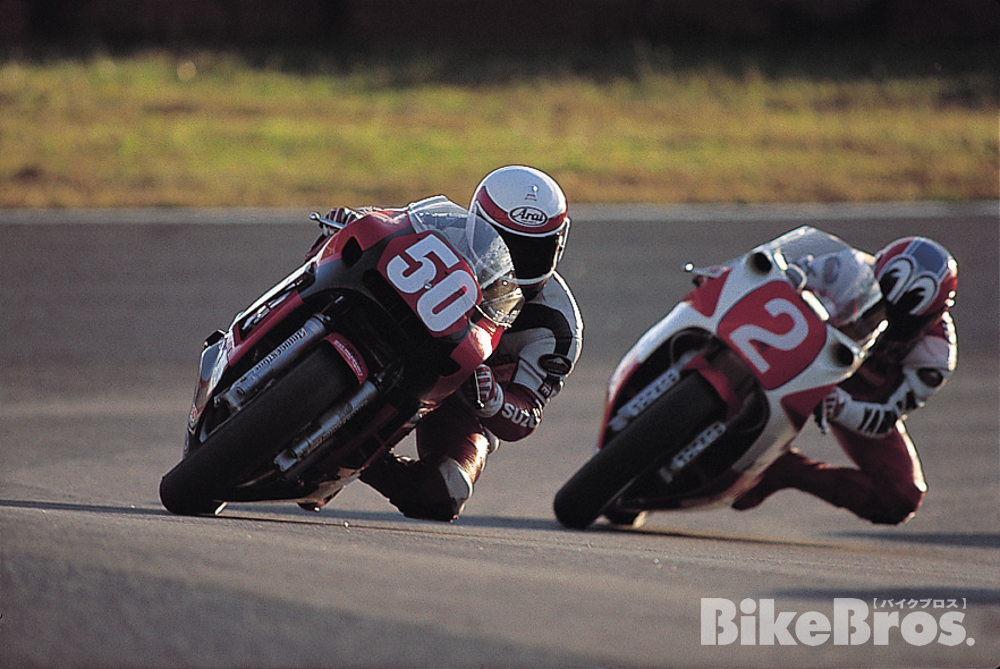
#50 Takayoshi (Yoshimura Suzuki GSX-R400) and #2 Shiomori (Yamaha YZF400) in the All-Japan TT-F3. Takayoshi was magnificent, challenging Honda RVF400 and Yamaha YZF400 in a head-to-head battle to finish 3rd in the ranking.
And then there was a race that would go down in history. Round 5 of the World Endurance Championship, the Suzuka 8 Hours.
Team Yoshimura entered the 1987 Suzuka 8H with #12 Kevin Schwantz / Oshima as ace and #45 Gary Goodfellow / Takayoshi as second team. As expected, #12 Schwantz qualified 3rd behind the Honda RVF750s. The first three qualifying positions were occupied by World GP500 riders Wayne Gardner, Niall Mackenzie, and Schwantz.
Schwantz’s main workplace is AMA Superbikes, but he was a vigorous spot rider in the World GP500 in 1986 and 1987 and was expected to be Suzuki’s next ace. Also aboard the #21 Yamaha Shiseido TECH21 Racing Team’s YZF750, which qualified 4th, was the World GP250 rider and World GP500 spot rider duo of Martin Wimmer / Magee.
The final race took a sharp turn soon after the start. After only 19 laps, Yoshimura’s ace #12 Schwantz had to retire due to a snapped cam chain that should not have snapped (it had never snapped before and there had been no similar problems with oil-cooled machines since). Oshima, who had been in good form, finished the race without running the final. It seemed that no team was able to close in on the leader, #1 Gardner / Dominique Sarron (Honda RVF750).
However, four hours into the race, on Lap 103, #1 Sarron crashed. It was Yoshimura’s second team, #45 Goodfellow / Takayoshi, who took the lead, with #21 Wimmer / Magee in 2nd and #7 Kork Ballington / Rob Phillis (Kawasaki ZXR-7) in 3rd. The #7 Kawasaki, registered as Team Green, was in fact a Kawasaki factory team, but then suffered engine trouble and retired on Lap 110.
The #45 Yoshimura was ahead with a big lead, followed by the #21 Yamaha TECH21. This picture continued into the final stint. Yamaha TECH21 gave Magee, aboard the #21, two consecutive stints as a strategy to catch up. The #45 Yoshimura rider was switched from Goodfellow to Takayoshi as scheduled, and by the time Takayoshi left the pit at 6.43pm, the lead was around 20 seconds. The two consecutive stint strategy requires riders to be not only tough but also fast in the dusk, and in the past, riders from the southern hemisphere such as Crosby and Gardner have been entrusted with two consecutive stints at the final stages of the Suzuka 8 Hours and achieved come-from-behind victories.
Lap times were 2 min 22-23 sec for #45 Takayoshi and 2 min 22 sec for #21 Magee. Due to the traffic on the track and other factors, the two riders’ lap times were around 2 to 3 seconds apart, but on average, #21 Magee was slightly faster, and the gap was gradually closing. Impatient with the situation, Pop commanded, “Show him the pace-up sign!”

The LIGHT-ON sign from Suzuka 8 Hours officials is usually presented around 6:45 p.m. The time may be earlier if it is cloudy or raining. At Suzuka in summer, darkness falls after 7 p.m., and the last 15 to 20 minutes of the race are pitch-dark.
Yet the Yoshimura pit did not immediately put up a PICK UP THE PACE signboard. Takayoshi was a rookie, it was his first Suzuka 8 Hours and he was riding at night. His fatigue must have reached its peak. Above all, the pressure of being in the lead was considerable. And the lead seemed to be enough for him to get away.
When the gap to #21 Magee was down to 9 seconds, Team Yoshimura finally gave the PICK UP THE PACE sign to #45 Takayoshi. The arrow on the sign changed from diagonally up to straight up (indicating the highest degree of urgency), and the number read “+9” (a 9-second lead over the bike behind). Takayoshi confirmed this and thought to himself, “Just as I thought, I gotta push the pace hard!”
“With 5 minutes to go, it’s probably 2 laps to go.” As Takayoshi entered Turn 1, he saw a lap rider in front of him and thought, “I’ll pass it from the inside at Turn 2,” but the lap rider was faster than expected. The front fender of Takayoshi’s bike touched the rear tire of the lap rider, and Takayoshi’s bike flipped over to the left hand (outside) of the course. From the upper seats of the grandstand, Yoshimura’s blue headlight, pointing in a strange direction and not moving, could be seen at Turn 2.
It turned out that a few laps before the crash, Takayoshi was actually running in the 2:22s range, but the Yoshimura crew mistakenly estimated that he was running in the 2:24s, 2 seconds off the pace. The signboard only displayed the lead over the rider behind (in seconds) and the direction of the arrow for pace-up/keep/pace-down. Takayoshi therefore increased his pace. Besides, the signboard could only convey the information of one lap before (today, the digital dashboard displays live lap times).
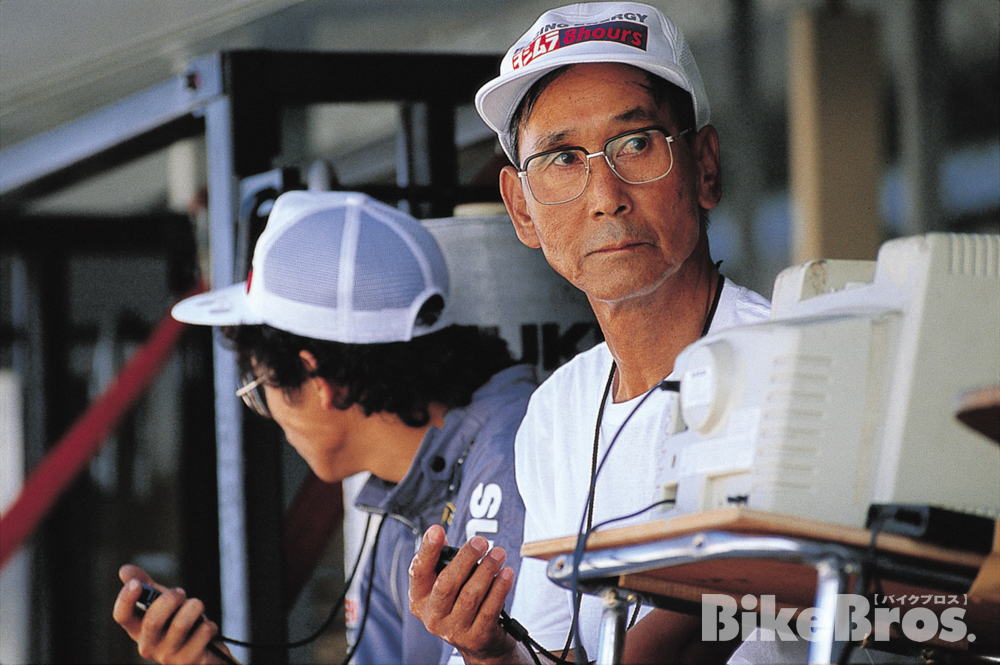
Will rookie Takayoshi be able to outrun Magee? Pop had left Fujio in charge of Team Yoshimura after his return from the hospital bed, but his habit of timing laptimes with a stopwatch remained the same. On the racetrack, Yoshimura, much like Pop’s personality, is good at catching up and fighting close battles for position, but somewhat less so when it comes to correctly judging a lead and defending it.
#21 Magee, who was 9 seconds behind the leader #45 Takayoshi, had given up on chasing Takayoshi at this point, as their lap times were evenly matched and time was running low. It seemed impossible for him to catch up to Takayoshi, and if he tried too hard and crashed, his team would lose their 2nd place podium finish. This was Yamaha TECH21’s third year in the Suzuka 8 Hours. They wanted to get a result.
Unaware that Magee had given up and slowed down, Takayoshi mistakenly thought his lap time was 2 seconds slower and tried to pick up the pace. Perhaps he rushed, or perhaps it was just bad luck, but Takayoshi failed to pass the lapped rider and crashed. He didn’t need to pick up the pace in the first place, but what had happened could not be undone.
The bike #45 did not roll to the far side of the wide gravel run-off area at Suzuka’s Turn 2. The bike was only a dozen meters away. Takayoshi’s body was barely intact, but the bike was buried in deep gravel and difficult to pick up.
The damage to the #45 was severe. The screen was cracked and gone, and the lower fairing was about to come off. The most worrisome part was the front brake. The master cylinder was fine, but the reservoir tank was hanging over the handlebar. Fortunately, the brakes worked. Takayoshi restarted. Whenever he tried to lean the bike even a little, the lower fairing grinded against the track surface. At the straight section the bike refused to go straight and tried to go right on its own. But no matter what, he had no choice but to take the checkered flag. Yoshimura staff and Takayoshi were praying, “Wave the checkered flag, now!”
Magee did not see the moment of Takayoshi’s accident and did not notice the bike #45 as he passed Turn 2. It was only when Magee returned to the main straight and saw the signboard that he knew he had taken the lead.
The #45 Yoshimura Suzuki GSX-R750 finished the race in 2nd place. The bike ran the same 200 laps as the winning #21 Yamaha TECH21 YZF750 and was 1 minute 19.176 seconds slower, which means it was almost half a lap behind the winner. The Yoshimura mechanics who received the bike #45 after the race were surprised that it was not black-flagged.
After the lap of honor, Takayoshi was carried into the control tower in the arms of officials and laid on his back on a sofa. Dehydration, exhaustion, and relief from extreme tension, all came at once.
“Good job, Takayoshi, you did great,” Pop praised.
“Thank you, you ran a great race,” Suzuki engineer Etsuo Yokouchi complimented.
“You did well, Katsuro, really well,” congratulated Takayoshi’s mother.
Takayoshi’s breathing was erratic and his compact body was convulsing. About 10 minutes later, Takayoshi was on the 2nd place podium with Goodfellow, and Pop was really happy to see them there. The high podium was surrounded by a huge wave of spectators. Tsujimoto, his senior, once called it the best view he had ever seen, but did Takayoshi even have a view of it? His face was lifeless, his gaze was not fixed, and his eyes seemed to be focused nowhere.
Takayoshi collapsed again after getting off the podium. Was it because he was released from tension after the podium ceremony? Yoshimura’s staff shed tears and thanked Takayoshi. It was a touching scene, but the truth was later revealed. Actually, Takayoshi had guzzled champagne at the ceremony to quench his extreme thirst, and suddenly became so drunk that he collapsed.
Still, the goddess of Suzuka 8 Hours is harsh on those at the top. Like Kenny Roberts / Tadahiko Taira’s engine blowout at 6:58 p.m. in 1985, or Takayoshi’s crash with 5 minutes to go in 1987. Sometimes there are more beautiful tales of losers than winners.
============================================================
Published on January 23, 2024
Stories and photos supplied by Yoshimura Japan / Takao Isobe / Tatsuo Sakurai
Written by Tomoya Ishibashi
Edited by Bike Bros Magazines
